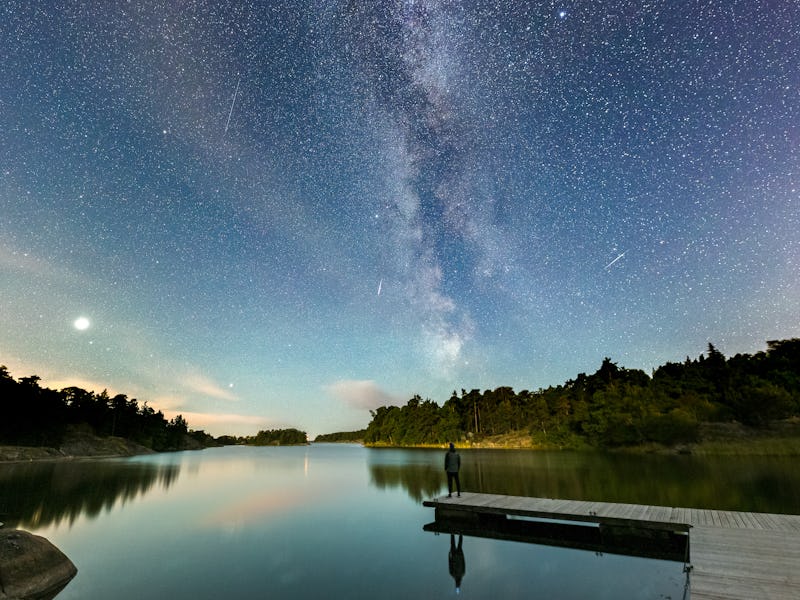Why this unexpected time is the best time for stargazing
Some celestial events are best viewed in the twilight.

The Sun dominates our daytime skies, burning bright above the horizon.
But the host star can’t compete with some of these skygazing events that are best viewed during the early morning, when the darkness of the night skies isn’t flooded by the bright aura of the Moon.
Although nighttime is often thought of as the best time to look up at the skies and observe nearby celestial objects, the early hours of the morning can also provide the ideal conditions for staring at the sky.
Stargazers during the nighttime usually have to avoid the moonlight, which washes out the light from many stars or meteor showers.
The Earth rotates through the night, and the early morning hours bring about new stars and planets scattered across the skies. And these cosmic bodies can be viewed in the quiet lull of the morning, before the rush of the daytime begins.
Venus, Jupiter, and Mars twinkle in the morning light
Venus, our Solar System neighbor, is the brightest planet in Earth’s sky.
The planet is visible in the eastern sky during the early morning hours during the month of January, as it shines under the light of dawn. This is when Venus is on the other side of the Sun, closer to the eastern horizon.
Evening sky gazing can get a bit crowded, the quiet morning light can provide some fascinating opportunities to look at celestial objects.
You can sometimes see Venus in broad daylight with the naked eye. But to really catch it, it’s best to look up during early morning hours, around 6 a.m. shortly after the Sun appears in the sky.
Jupiter is further up in the eastern sky, and can often be right at the horizon by the end of December. The largest planet of the Solar System is bright enough to see with the naked eye during the day, and a backyard telescope will provide an even better look at the gas giant planet.
With the naked eye, the planet looks like a bright spot of light, but a telescope or even a pair of binoculars will give it more definition and often a view of its largest moons.
Mars is another one of the Solar System’s brightest planets. You can see Mars from dusk until dawn, although it is the trickiest out of the three planets to spot since it is rather small. Look for Mars slightly above Jupiter, and maybe grab a pair of binoculars to capture the Red Planet.
These two planets are best viewed in this position towards the end of December and into early January.
Mercury at elongation
The elusive Mercury can also be seen in the morning hours as it reaches its greatest western elongation.
Throughout the latter half of October, Mercury will be at its furthest position from the Sun, giving it enough separation to not be drowned out by the Sun’s light just before sunrise.
The planet reaches the moment of greatest western elongation on October 25, 2021, right before sunrise at around 6 a.m. Eastern. Mercury will continue to be visible in the sky during the early morning hours until early November 2021.
The planet will be most visible in the sky shortly before sunrise if you look towards the northeastern horizon. The best time to step outside is about one hour before Sun up.
Mercury can be seen with the naked eye looking to the east, but a pair of binoculars might also be handy if you want to catch the planet glimmer in the twilight.
Stars shine during the day
As strange as it may sound, some stars can also twinkle during the day. The brightest stars in our skies have been known to show themselves along with the Sun.
But in order to see them, you will need a telescope. With the Sun over in the western sky, point the telescope towards the south to view the stars a couple of hours before sunset. The brightest, most familiar stars, like Betelgeuse, are the ones that will be the easiest to spot.
Seeing the Sun
And of course, the best star to view during the day is none other than the Sun.
But observing the Sun comes with a view cautionary tips in order to avoid damage to your eyes from the star’s strong radiation. Therefore, it’s always recommended to look at the Sun indirectly or through a solar filter.
Project the view of the Sun from a telescope or a pair of binoculars onto another surface, like a small card. Specialized solar telescopes are not exactly for amateurs, but they do provide fascinating views of the Sun’s fiery eruptions.
This article was originally published on